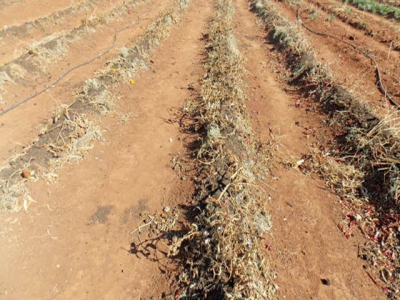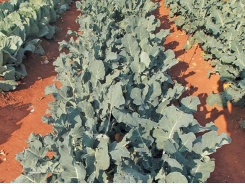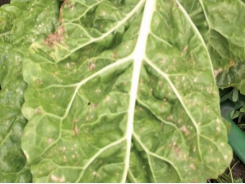No-till: increasing soil organic content

With no-till farming, you need to try to gradually increase the organic content of the soil.
Pepper crop residue topped with compost and ready for planting. It looks ‘unprofessional’, but the crops will thrive and humus will accumulate. Photo: Bill Kerr
With no-till farming, you need to try to gradually increase the organic content of the soil.
As mentioned in previous articles, this helps increase the fertility, taste and nutrient content of your produce, conserves water and makes farming easier and less hazardous.
Just by not tilling, you drastically reduce the loss of carbon (C) from the soil.
All micro-organisms in the soil are eating to stay alive, and are, thus, releasing carbon dioxide into the air. The higher the organic content, the more soil organisms present, and the greater the loss of C through the release of carbon dioxide.
In order to maintain the soil organic content at a higher level, you have to provide more ‘carbon-containing’ food for the organisms. This is similar to maintaining livestock: the more animals you have, the more feed you need to provide.
There are other advantages to increasing the soil’s organic matter, but there are limits as to how high you can maintain the content.
Soil type, climatic conditions and types of crops grown will all have an effect.
Fortunately, with vegetables, bringing in an external source of C in the form of manure and compost can be very economical and quicken the build-up of organic matter.
It took me 16 years to go from 1,5% to 4,9% organic matter.
I achieved this with compost and a legume winter cover crop. If I had to stop these practices and continue to implement no-till, it would take many years to degrade; in other words, I’ve accumulated a lot of ‘soil wealth’ for the future.
Remember, in order for humus to build up from raw organic matter, there always has to be enough nitrogen (N) present due to the C:N ratio of humus, as described in a previous article.
Interesting figures
Bearing in mind that humus has a C:N ratio of 10:1, some interesting figures emerge when calculating how much C and N are tied up in my soil’s organic matter.
An accurate figure is dependent on the soil density, but as a rule of thumb there’s about 24t per percentage point of organic matter on 1ha of soil 20cm deep.
Organic matter is 58% C. With my soil at about 4,9% organic matter, I have 118t of organic matter at 58% C, or 68t of C/ha, or 6,8t of N.
Two interesting points arise from this. First, the N content is enormous. As I did not apply any artificial fertilisers over the 16-year period, this came from a little manure, lots of compost and the legume cover crops.
A fair amount would also have been produced from the free-living nitrogen-fixing organisms present in healthy, organic soil.
The second point is that I have an enormous reserve of N stored in a non-leachable form. You can even calculate the value of this from the cost of nitrogenous fertilisers.
Don’t underrate it
The organisms associated with this humus make many normally unavailable nutrients available to plants, and also help buffer imbalances and neutralise toxins. It’s a pity, then, that many farmers grossly underrate soil organic matter.
Related news
Tools

Phối trộn thức ăn chăn nuôi

Pha dung dịch thủy canh

Định mức cho tôm ăn

Phối trộn phân bón NPK

Xác định tỷ lệ tôm sống

Chuyển đổi đơn vị phân bón

Xác định công suất sục khí

Chuyển đổi đơn vị tôm

Tính diện tích nhà kính

Tính thể tích ao




 The basics of maize production
The basics of maize production  Beware of that foliar feed mixture!
Beware of that foliar feed mixture!